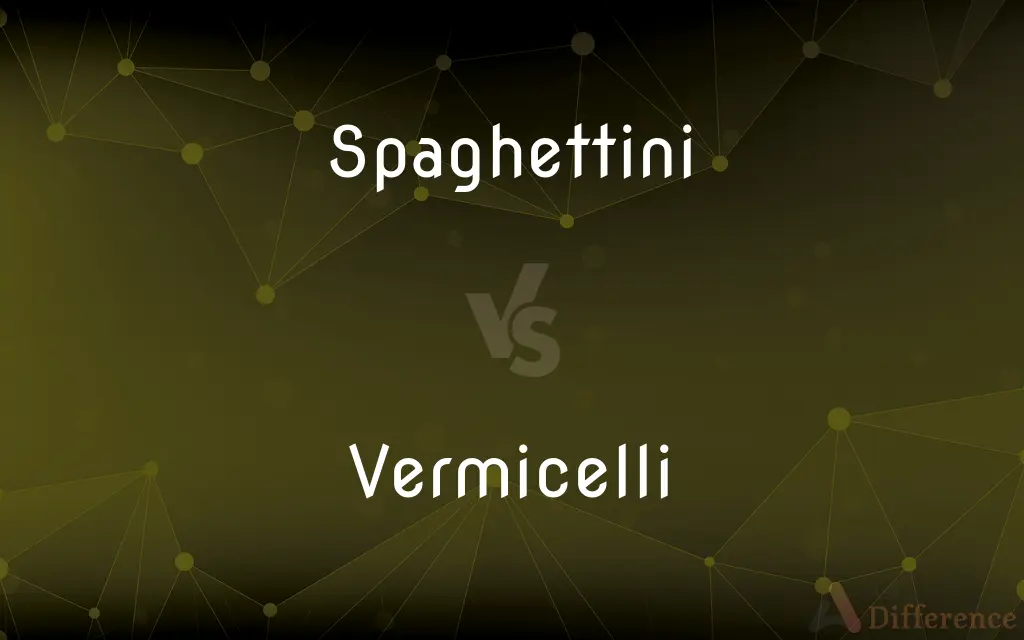Spaghettini vs. Vermicelli — What's the Difference?
Edited by Tayyaba Rehman — By Maham Liaqat — Updated on April 2, 2024
Spaghettini is a thinner version of spaghetti, while vermicelli refers to thin pasta in Italian cuisine but can indicate rice noodles in Asian contexts.

Difference Between Spaghettini and Vermicelli
Table of Contents
ADVERTISEMENT
Key Differences
Spaghettini, often considered a finer version of spaghetti, is known for its thin strands that are slightly thicker than angel hair pasta. This Italian pasta cooks quickly due to its slender shape and is ideal for delicate sauces. On the other hand, vermicelli in Italian cuisine refers to a very thin pasta, similar to thin spaghetti, but the term can also refer to thin, rice-based noodles in Asian culinary traditions, showcasing a versatility in ingredient composition and culinary use.
In terms of texture and cooking time, spaghettini, with its fine strands, offers a delicate bite and a shorter cooking duration compared to traditional spaghetti. Vermicelli, especially the rice noodle variety, presents a lighter texture and absorbs flavors well, making it suitable for a variety of broths, stir-fries, and salads in Asian dishes. When referring to Italian vermicelli, it's slightly thicker than spaghettini and can handle slightly heartier sauces.
Culturally, spaghettini holds its roots firmly in Italian cuisine, embodying the Italian penchant for matching specific pasta shapes to corresponding sauce types. Vermicelli, on the other hand, straddles various culinary worlds, serving as a staple in Italian, Vietnamese, Chinese, and other Asian cuisines, adapting its form and preparation methods to fit local tastes and ingredients.
The preparation and serving of spaghettini often involve light, olive oil-based sauces, fresh herbs, and seafood, emphasizing the pasta's ability to complement subtle flavors. Vermicelli noodles in Asian cuisine are frequently served with a mix of fresh vegetables, herbs, and various proteins, doused in flavorful sauces or broths, highlighting the noodle's versatility in absorbing and enhancing the flavors with which it is served.
Choosing between spaghettini and vermicelli depends on the desired dish's culinary context and flavor profile. Spaghettini is preferred for traditional Italian dishes that require a delicate pasta, while vermicelli's adaptability makes it a go-to option for a range of Asian-inspired dishes or a lighter, thinner pasta option in Italian recipes.
ADVERTISEMENT
Comparison Chart
Thickness
Thinner than spaghetti but thicker than angel hair pasta.
Varies; thinner in Italian cuisine, can be very thin rice noodles in Asian cuisine.
Composition
Made from wheat and water.
Can be made from wheat (Italian) or rice flour (Asian).
Culinary Traditions
Italian cuisine.
Italian and various Asian cuisines.
Ideal Sauces
Light, delicate sauces.
Adapts to a wide range; light broths to rich sauces depending on the region.
Cooking Time
Quick cooking due to thinness.
Varies; rice vermicelli cooks very quickly, while wheat vermicelli may take slightly longer.
Texture
Delicate and fine.
Texture varies; generally light, especially rice vermicelli.
Usage
Best with light seafood or vegetable-based sauces.
Versatile; used in soups, stir-fries, salads, or as a base for sauces.
Compare with Definitions
Spaghettini
A thinner version of spaghetti ideal for light sauces.
The chef prepared spaghettini with a garlic and olive oil sauce.
Vermicelli
Thin noodles that can be made from wheat or rice.
Vermicelli noodles were the base for the spring rolls.
Spaghettini
Italian pasta suited for delicate dishes.
Lemon and basil spaghettini is a summer favorite.
Vermicelli
Versatile in Italian and Asian dishes.
For dinner, vermicelli was served with a spicy tomato sauce.
Spaghettini
Fine, wheat-based pasta that cooks quickly.
Spaghettini was chosen for its delicate texture complementing the shrimp.
Vermicelli
Adapts well to both light and hearty toppings.
Vermicelli with hearty beef broth is a Vietnamese staple.
Spaghettini
Perfect for quick, refined meals.
They enjoyed spaghettini with clams as a quick yet sophisticated dinner.
Vermicelli
A staple in various global cuisines for its adaptability.
Vermicelli salad with herbs and lime dressing was refreshing.
Spaghettini
Thin pasta that highlights subtle flavors.
The light tomato basil sauce was perfect with spaghettini.
Vermicelli
Rice vermicelli often used in stir-fries and soups.
The beef stir-fry featured rice vermicelli soaked in soy sauce.
Spaghettini
Pasta in long fine strands.
Vermicelli
Vermicelli (Italian: [vermiˈtʃɛlli]; lit. 'little worms', , also UK: , ) is a traditional type of pasta round in section similar to spaghetti. In English-speaking regions it is usually thinner than spaghetti, while in Italy it is typically thicker.The term vermicelli is also used to describe various types of thin noodles from Asia.
Spaghettini
A form of thin spaghetti
Vermicelli
Pasta in the form of long slender threads.
Spaghettini
Thin spaghetti
Vermicelli
Shreds of chocolate used to decorate cakes or other sweet foods.
Vermicelli
Pasta in long, very thin strands.
Vermicelli
Long, slender pasta, similar to spaghetti, only thinner.
Vermicelli
Any type of long, thin noodles, as in rice vermicelli.
Vermicelli
(UK) Chocolate sprinkles.
Vermicelli
The flour of a hard and small-grained wheat made into dough, and forced through small cylinders or pipes till it takes a slender, wormlike form, whence the Italian name. When the paste is made in larger tubes, it is called macaroni.
Vermicelli
Pasta in strings thinner than spaghetti
Common Curiosities
Can spaghettini and vermicelli be used interchangeably in recipes?
While they can sometimes be substituted for one another, their differences in thickness, texture, and traditional culinary uses suggest choosing the one that best fits the dish's intended flavor profile and texture.
What's the main difference between spaghettini and vermicelli?
Spaghettini is a thinner form of spaghetti used in Italian dishes, while vermicelli refers to both a type of thin Italian pasta and thin rice noodles used in Asian cuisines.
What are some traditional dishes that use spaghettini?
Spaghettini is often used in dishes with light, olive oil-based sauces, such as spaghettini aglio e olio (with garlic and oil) or with seafood.
How do you properly cook rice vermicelli?
Rice vermicelli is typically soaked in hot water for a few minutes until soft, then drained and added to dishes, ensuring it doesn't become too soft or mushy.
What is the best way to serve rice vermicelli?
Rice vermicelli is best served in light broths, salads, or stir-fried with vegetables and protein, allowing it to absorb the dish's flavors.
How does the cooking time of spaghettini compare to traditional spaghetti?
Spaghettini has a shorter cooking time due to its thinner strands, making it a quicker option for pasta dishes.
What makes vermicelli a versatile ingredient in cooking?
Its ability to adapt to various culinary traditions and dishes, from Italian pasta recipes to Asian stir-fries and soups, makes vermicelli versatile.
What are some key tips for cooking spaghettini to perfection?
Use plenty of boiling, salted water and stir occasionally to prevent sticking, cooking until al dente for the best texture.
Is there a nutritional difference between spaghettini and vermicelli?
Yes, the main difference lies in their base ingredients (wheat vs. rice), impacting their calorie, carb, and gluten content.
Is vermicelli gluten-free?
Rice-based vermicelli is gluten-free, making it suitable for those with gluten sensitivities or celiac disease, whereas wheat-based vermicelli and spaghettini contain gluten.
Can I use spaghettini in place of vermicelli in a Vietnamese noodle dish?
While not traditional, spaghettini can be used as a substitute in a pinch, though the texture and flavor absorption may differ from rice vermicelli.
Why might someone prefer rice vermicelli over wheat-based noodles?
Dietary restrictions, like gluten intolerance, or a preference for the lighter texture and flavor profile of rice vermicelli might influence this choice.
How has the use of vermicelli evolved in global cuisines?
Vermicelli has adapted to various culinary traditions, from a simple pasta dish component to a versatile ingredient in diverse Asian cuisines.
Are there any specific sauces that pair well with spaghettini?
Light and delicate sauces, especially those based on olive oil, garlic, and fresh herbs, pair well with spaghettini, allowing its texture to shine.
How do I choose between spaghettini and vermicelli for a recipe?
Consider the recipe's origin (Italian vs. Asian), the desired texture, and how the pasta or noodle will interact with other ingredients and sauces.
Share Your Discovery

Previous Comparison
Evolve vs. Develop
Next Comparison
Dimension vs. AspectAuthor Spotlight
Written by
Maham LiaqatEdited by
Tayyaba RehmanTayyaba Rehman is a distinguished writer, currently serving as a primary contributor to askdifference.com. As a researcher in semantics and etymology, Tayyaba's passion for the complexity of languages and their distinctions has found a perfect home on the platform. Tayyaba delves into the intricacies of language, distinguishing between commonly confused words and phrases, thereby providing clarity for readers worldwide.
















































